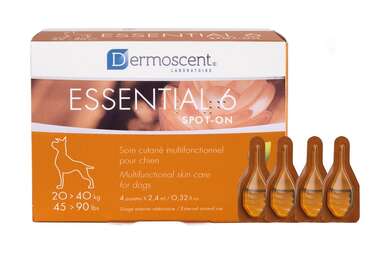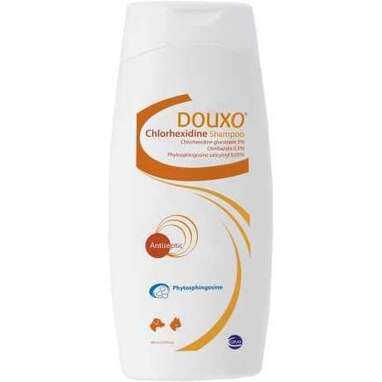How Can I Get Rid Of My Dog's Dry Skin?
Moisturized and unbothered 💅🏻✨

After a petting sesh with your pup, it can be kind of alarming to see dandruff coming from his skin, especially if this is your first time seeing it.
Your dog’s dandruff can actually be a sign that your dog is suffering from dry skin and that he should go to the veterinarian for a diagnosis and treatment plan.
Dry skin on dogs can come from several causes, from something totally harmless, like dry air, to something more serious, like Cushing’s disease. And the cause of your pup’s skin issues will determine the course of treatment.
The Dodo reached out to a few veterinarians to find out the causes of dry skin on dogs, how vets diagnose the condition and how it’s typically treated.
Signs of dry skin on dogs
Your dog might have dry skin if he shows one of the following changes in behavior or appearance:
- Itching, licking, biting or scratching
- Rolling around
- Dull coat
- Hair loss
- Dandruff
- Red rashes or scabs
- Inflammation
- Oily skin
- Change in your dog’s odor
- Depression
Why does my dog have dry skin?
“Dry skin in dogs can have a range of causes, including over-bathing, improper nutrition, parasites, allergies, dry air and hormonal disorders,” Dr. Linda Simon, a veterinary surgeon and veterinary consultant for FiveBarks, told The Dodo.
Here are some common causes of dry skin on dogs:
Allergies
Dogs can be allergic to things in their environment or in their food, which can cause a variety of allergy symptoms, including dry skin.
When it comes to dry skin causes in dogs, “allergies are the most common,” Dr. Erica Irish, a veterinary advisor at betterpet, told The Dodo.
It’s super important to bring your dog to the vet if you suspect he’s suffering from allergies because if left untreated, the dry, itchy skin from allergies can develop into a secondary infection.
At the vet, they might recommend an antihistamine or a treatment known as immunotherapy, which changes your dog’s immune system response to allergens, to reduce your dog’s symptoms (and ultimately heal his dry skin).
Talk to your vet if you suspect your dog is suffering from allergies to determine the best treatment for your pup.
Parasites
Your dog can also get dry skin from parasites, like lice, mites and fleas.
Flea allergy dermatitis (aka an allergy to fleas) is pretty common in dogs, and it can lead to itchy, dry skin if a flea bites an allergic dog.
Other parasites, like lice and mites, can cause several skin issues, including dry skin.
Bacterial or fungal infections
Skin infections, like ringworm or yeast overgrowth, can cause a ton of skin issues, including dry skin.
To diagnose your pup for bacterial or fungal infections, your vet might take skin scrapings for cytology (aka look at a sample of your pup’s skin under a microscope). It sounds like it hurts, but this process will cause your dog only some discomfort at worst.
Some of these infections can be contagious to humans, so it’s super important to get your pup checked out by a vet ASAP to potentially prevent it from spreading to you or your family.
Systemic disorders
In some cases, dry skin can be caused by a serious disorder.
Some conditions that can cause dry skin in dogs include Cushing’s disease, hypothyroidism, autoimmune disorders and cancer (the first two are the most common causes of dry skin).
Breed-specific skin conditions
Some breeds are prone to developing skin issues, including dry skin.
“We can also see certain medical issues in specific breeds, such as zinc responsive dermatoses [aka a zinc deficiency in the body] in Siberian huskies,” Dr. Simon said.
Alaskan malamutes and large-breed puppies are also susceptible to a zinc deficiency in the body, which can cause dry skin.
Other causes of dry skin on dogs
Dry skin can be caused by a variety of environmental factors, including the following:
- Cold temperature
- Dry air
- Overbathing
- Harsh soaps
- Poor diet
Even if you think the cause of your dog’s dry skin is from one of the above factors, you should still take him to the veterinarian for a proper diagnosis.
Diagnosing dry skin on dogs
“Your vet will do a full health check, which may include blood tests to look for reasons for your pet’s dry coat,” Dr. Corinne Wigfall, a veterinarian with SpiritDog Training, told The Dodo. “They will take a full history of diet, flea treatment, bathing routine and home environment to try and work out the cause.”
Your vet will also perform a series of skin tests, such as hair analysis (aka trichogram), skin tape prep (aka looking at the skin cells under a microscope) and a culture of a swab taken from scabs.
Dog dry skin treatment
The cause of your dog’s dry skin will determine how it should be treated.
“If the vet finds external parasites are the cause (fleas, ticks, etc.), this will be treated with flea treatments,” Dr. Wigfall said.
“If the cause is medical, such as hypothyroidism or Cushings, medications will be started,” Dr. Wigfall said. “This is the only way to cure the skin problem. All the baths/lotions in the world will not cure scaly skin that is related to a hormonal imbalance.”
If allergies are causing your pup’s dry skin, your vet might prescribe medications, topical treatments, veterinary diets and/or supplements. “As they are lifelong conditions, treatment is based around management of the clinical signs,” Dr. Wigfall said.
“If the cause is related to [the] owner’s choice of diet or shampoos, advice will be given on more suitable products for your dog’s needs,” Dr. Wigfall said.
Keep in mind that treatment won’t happen overnight. It will take some time before your pup’s dry skin starts to improve. “The skin takes roughly six to eight weeks to go through the growth-shedding cycle, so any improvements will often not be seen for at least six weeks after starting treatments or supplements,” Dr. Wigfall said.
How to help dogs with dry skin at home
In addition to any treatments your vet might prescribe, there are some things you can do at home to provide relief and make sure your pup heals properly during treatment.
Brush your dog. This will help remove some dandruff from your dog’s skin and provide him some relief from itchiness.
Use a conditioning shampoo. This will help moisturize flaky skin and reduce itchy sensations. “Do not use shampoo on your dog if you can see redness of the skin, spots, open wounds or discharge of any sort,” Dr. Wigfall said. “Oatmeal and aloe vera are good ingredients to keep an eye out for.”
Use a cone. If your dog is nibbling at his dry skin, “this will reduce the chance of secondary bacterial infection from further trauma and bacteria,” Dr. Wigfall said.
Trim his nails. “Keeping your dog’s nails short will help reduce the chances of secondary infection from scratching at dry skin,” Dr. Wigfall said.
How to prevent dry skin on dogs
You can prevent dry skin from affecting your dog by grooming him properly, feeding him a high-quality diet and staying up to date with parasite prevention medication.
When it comes to grooming, keep baths to a minimum and make sure you’re using a dog-safe shampoo. “Bathing your dog should be performed a maximum of once a week,” Dr. Wigfall said. “Any more and it strips the oils from the coat.”
“Use a dog-specific shampoo and look for a product that has a conditioning element, such as oatmeal,” Dr. Wigfall added.
You should also plan to brush your dog pretty often. “Brush the coat at least once a week to help promote good circulation to the skin and move the oils down the hair shafts,” Dr. Wifgall said.
Nutrition also plays a role in your dog’s skin health. You should opt for dog foods that are complete and balanced nutritionally and use whole foods for their ingredients.
Keep in mind, though, that if you feed your dog home-cooked or raw foods, his meals may not have all the essential nutrients dogs need for healthy skin,” Dr. Wigfall said. “Talk to your vet or veterinary nutritionist for advice on meeting your dog’s needs.”
You should keep an eye out for skin issues in your dog, and make sure you go to your vet ASAP if you notice he’s showing symptoms of dry skin. “The sooner you treat this problem, the easier it can be to resolve it before the dry skin becomes established,” Dr. Wigfall said.
What can I use for my dog’s dry skin?
Below are some vet-recommended products that can help with your dog’s dry skin. But be sure to talk to your vet so they can prescribe the best treatment for your pup.

This product is a blend of dog-safe essential oils that will help balance your pup’s skin and fix any dryness.
“Dermoscent 6, a topical application of essential fatty acids, is another excellent product that is as easy as a topical flea treatment to apply,” Dr. Wigfall said.

Veterinary diets that target skin issues, such as the Derm line from Hill’s, “are scientifically proven to improve skin health,” Dr. Wigfall said. “You will need to consult with your veterinarian as to which type is the best for your individual pet’s needs.”

“Douxo has an excellent skin care line for medicated and moisturizing products,” Dr. Irish said. This dog shampoo features ingredients that are key to promoting healthy skin, like chlorhexidine and climbazole.
If your pup is dealing with dry skin, that’s a good sign that you should take him to a vet. The best case scenario is that the air in your home is too dry, causing his dry skin, but you can never be too careful.
Your vet can then prescribe treatment to fix his skin so he can finally get back his healthy glow.
We independently pick all the products we recommend because we love them and think you will too. If you buy a product from a link on our site, we may earn a commission.